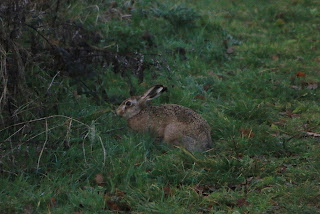| House sparrow | Magpie | Red kite |
| Blue tit | Starling | Buzzard |
| Great tit | Blackbird | Little egret |
| Long-tailed tit | Crow | Robin |
| Bullfinch | Redwing | Mallard |
| Chaffinch | Fieldfare | Pied wagtail |
| Goldfinch | Song thrush | House martin |
| Greater-spotted Woodpecker | Dunnock |
 |
| House sparrow |
 |
| Greater spotted woodpecker |
 |
| Fieldfare |
 |
| Redwing |
 |
| Chaffinch |
 |
| Little egret |
There is nothing exceptional on the list and there were no greenfinches, coal tits, jackdaws, yellowhammers and so on which might be plausible. As the estate matures and gardens are established, it will be interesting to see the impact. Hopefully it will create greater diversity, which might seem odd given that we started with a green field!
So far just 3 mammals, muntjac, pipistrelle 45 bats, and fox. We saw another fox last weekend at 3.40 am - its barking woke everyone up.
I have adjusted my moth count to 104 because I missed out one trapping night, and a red underwing seen in the day time against the brickwork of a neighbour's house. The commonest by number have been:
1 Brimstone
2 Setaceous hebrew character
3= Large yellow underwing
3= Dark arches
5 Heart and dart
 |
| Dark arches |
 |
| Brimstone |
The results are however unrepresentative because we missed most of the autumn. Next year I plan to trap at least monthly, and more often in the warmer summer months.
Yesterday I walked over towards Whichford. A common oak tree had dropped its acorns or rather the knopper galls that had overwhelmed it; the tree is a full 1.7 km from nearest Turkey oak that I know of in the village. A few weeks ago I met Mick Crawley who in the 1990's researched knopper galls. Interestingly he could not nail down just how far from a Turkey oak the fly responsible, Andricus quercuscalicis will travel between the two oak species needed for its life cycle. The females are just about to emerge from the galls and I brought back a few galls to examine them when they emerge.










































